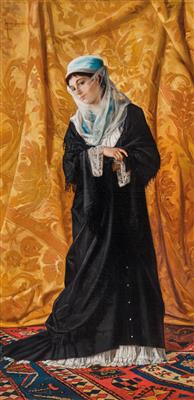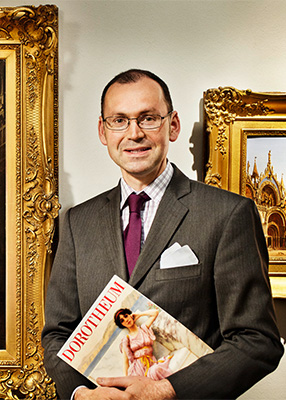Osman Hamdi Bey

(Istanbul 1842–1910)
Dame turque de Constantinople, signed, dated Hamdy. Bey.1881, oil on canvas, 120 x 60 cm, framed, (GG)
Provenance:
Private Collection Italy.
Compare:
Sotheby’s 30. May 2008, lot 100.
Created in 1881, this magnificent painting is amongst Hamdi Bey’s finest works. La Dame Turque is a full-length portrait of a woman looking directly at the viewer from behind a diaphanous yasmak. She wears a ferace, an outdoor coat, over her anteri. The dark colour suggests a connection to traditional Turkish formal style. She is standing on a richly patterned Kazak rug which may have been inspired by the artist’s collection, against a backdrop of fabric lavishly embroidered with gold thread.
Hamdi Bey can be considered the first Turkish painter to embrace the Western style of painting. The present lot reflects both traditional Turkish values and the latest Parisian fashions. It was en vogue in contemporary Constantinople to order dresses in Paris or commission them from seamstresses in Pera, a district on the European side of the city.
Hamdi Bey was sent to study law in Paris from 1860 to 1869 by his father, the Grand Vizier Ibrahim Edhem Pasha, but broke off his legal training to focus on painting. He trained under Gustave Boulanger and worked in his studio. He appeared at the Paris Salon for the first time not as a painter, but as a model. Indeed, one of the two paintings that his master Gustave Boulanger exhibited at the 1865 Salon bore the title of “Portrait of Hamdi Bey”. Hamdi Bey was admitted to the Salon as a painter the following year.
He was also greatly influenced by the academic painter Jean-Léon Gérôme. The young Ottoman artist studied Gérôme’s paintings at the École des Beaux-Arts in Paris in the early-1860s, where the renowned orientalist painter was appointed professor in 1864. Thus both Boulanger and Gérôme played a crucial role in Hamdi Bey’s career.
In 1867, Sultan Abdülaziz visited the Paris Exposition Universelle, where Hamdi Bey exhibited three works for which he was awarded medals. He was one of the most highly regarded Turkish painters in 1860s Paris. He met a French lady, Marie, who would become his wife and who accompanied him back to Constantinople in 1869. On his return from Paris he was posted to Baghdad to work under the newly appointed governor of the city. In 1881 Sultan Abdul Hamid II appointed him as Director of the Ottoman Imperial Museum in Constantinople, and Principal of the Imperial School of Arts, likewise in Constantinople, in 1883. In 1882 Hamdi Bey established the Sanayi-i Nefise Mektebi (Academy of Fine Arts) to help Ottoman artists to study within Turkey rather than being forced to travel to Europe.
Hamdi Bey continued to exhibit his works internationally and won numerous awards. He was an accomplished musician, a fine poet and writer, but also a renowned archaeologist. He discovered the so called Sarcophagus of Alexander at Sidon in the Lebanon in 1887, which was subsequently shipped to Constantinople to be housed in the new museum building in the Topkapı Palace; the collection opened to the public in 1891. In addition, Hamdi Bey was an accomplished musician and a fine poet and writer. He was a dominant force within Turkish culture during the second half of the nineteenth century and can be considered the archetypal painter of modern Turkish life, building bridges between the Orient and the Occident.
A larger version of the present lot was auctioned at Sotheby’s London on 30 May 2008, as lot 100. The present composition is privately owned and has always been hidden from public view.
Esperto: Gautier Gendebien
 Gautier Gendebien
Gautier Gendebien
+39-334-777 1603
Gautier.Gendebien@dorotheum.it
23.10.2019 - 17:00
- Prezzo realizzato: **
-
EUR 1.770.300,-
- Stima:
-
EUR 1.500.000,- a EUR 1.800.000,-
Osman Hamdi Bey
(Istanbul 1842–1910)
Dame turque de Constantinople, signed, dated Hamdy. Bey.1881, oil on canvas, 120 x 60 cm, framed, (GG)
Provenance:
Private Collection Italy.
Compare:
Sotheby’s 30. May 2008, lot 100.
Created in 1881, this magnificent painting is amongst Hamdi Bey’s finest works. La Dame Turque is a full-length portrait of a woman looking directly at the viewer from behind a diaphanous yasmak. She wears a ferace, an outdoor coat, over her anteri. The dark colour suggests a connection to traditional Turkish formal style. She is standing on a richly patterned Kazak rug which may have been inspired by the artist’s collection, against a backdrop of fabric lavishly embroidered with gold thread.
Hamdi Bey can be considered the first Turkish painter to embrace the Western style of painting. The present lot reflects both traditional Turkish values and the latest Parisian fashions. It was en vogue in contemporary Constantinople to order dresses in Paris or commission them from seamstresses in Pera, a district on the European side of the city.
Hamdi Bey was sent to study law in Paris from 1860 to 1869 by his father, the Grand Vizier Ibrahim Edhem Pasha, but broke off his legal training to focus on painting. He trained under Gustave Boulanger and worked in his studio. He appeared at the Paris Salon for the first time not as a painter, but as a model. Indeed, one of the two paintings that his master Gustave Boulanger exhibited at the 1865 Salon bore the title of “Portrait of Hamdi Bey”. Hamdi Bey was admitted to the Salon as a painter the following year.
He was also greatly influenced by the academic painter Jean-Léon Gérôme. The young Ottoman artist studied Gérôme’s paintings at the École des Beaux-Arts in Paris in the early-1860s, where the renowned orientalist painter was appointed professor in 1864. Thus both Boulanger and Gérôme played a crucial role in Hamdi Bey’s career.
In 1867, Sultan Abdülaziz visited the Paris Exposition Universelle, where Hamdi Bey exhibited three works for which he was awarded medals. He was one of the most highly regarded Turkish painters in 1860s Paris. He met a French lady, Marie, who would become his wife and who accompanied him back to Constantinople in 1869. On his return from Paris he was posted to Baghdad to work under the newly appointed governor of the city. In 1881 Sultan Abdul Hamid II appointed him as Director of the Ottoman Imperial Museum in Constantinople, and Principal of the Imperial School of Arts, likewise in Constantinople, in 1883. In 1882 Hamdi Bey established the Sanayi-i Nefise Mektebi (Academy of Fine Arts) to help Ottoman artists to study within Turkey rather than being forced to travel to Europe.
Hamdi Bey continued to exhibit his works internationally and won numerous awards. He was an accomplished musician, a fine poet and writer, but also a renowned archaeologist. He discovered the so called Sarcophagus of Alexander at Sidon in the Lebanon in 1887, which was subsequently shipped to Constantinople to be housed in the new museum building in the Topkapı Palace; the collection opened to the public in 1891. In addition, Hamdi Bey was an accomplished musician and a fine poet and writer. He was a dominant force within Turkish culture during the second half of the nineteenth century and can be considered the archetypal painter of modern Turkish life, building bridges between the Orient and the Occident.
A larger version of the present lot was auctioned at Sotheby’s London on 30 May 2008, as lot 100. The present composition is privately owned and has always been hidden from public view.
Esperto: Gautier Gendebien
 Gautier Gendebien
Gautier Gendebien
+39-334-777 1603
Gautier.Gendebien@dorotheum.it
|
Hotline dell'acquirente
lun-ven: 10.00 - 17.00
kundendienst@dorotheum.at +43 1 515 60 200 |
| Asta: | Dipinti dell’Ottocento |
| Tipo d'asta: | Asta in sala |
| Data: | 23.10.2019 - 17:00 |
| Luogo dell'asta: | Wien | Palais Dorotheum |
| Esposizione: | 12.10. - 23.10.2019 |
** Prezzo d'acquisto comprensivo di tassa di vendita e IVA
Non è più possibile effettuare un ordine di acquisto su Internet. L'asta è in preparazione o è già stata eseguita.
